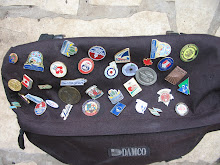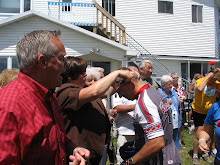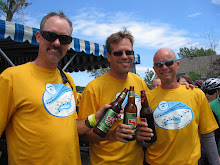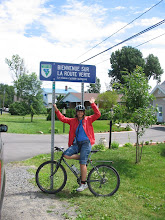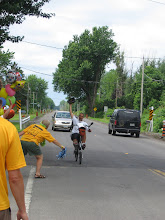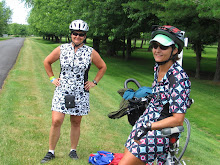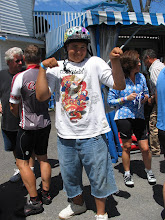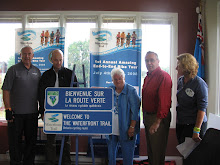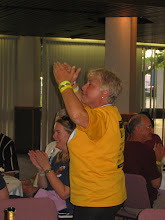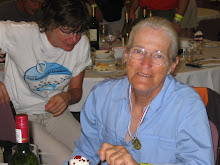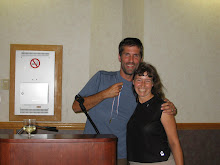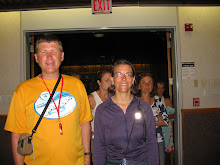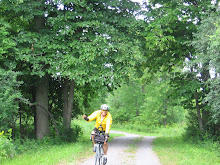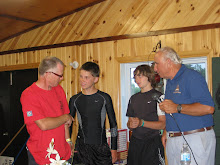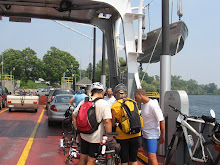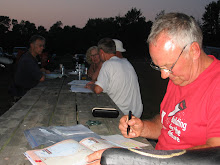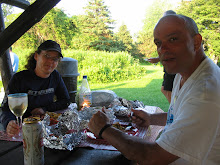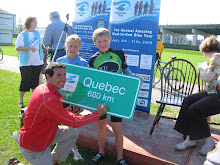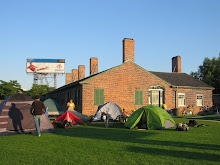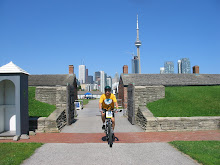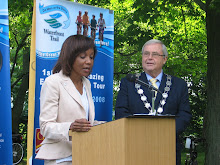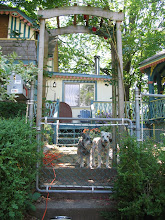I can’t say that I miss getting up and riding 100 k every day but there’s one thing I do miss – the sense of connection this great effort engendered, connection to other people, to the land, to the lake.
We travelled a long way through very disparate communities but everywhere received a wonderful welcome from people with a genuine appreciation for what we were doing. We were a disparate bunch of riders, ranging in age from 10 to 76, with six over the age of 70, and 14 under 18. A total of 148 completed the end-to-end and received the weighty zinc medallions bearing the bird, leaf, fish symbol of the waterfront trail.
Most of us were from Ontario, 8 came from elsewhere in Canada (4 from Alberta) and 9 from the US (5 from Texas). Toronto sent the most people with 19 and Ajax sent 12, including their mayor. For the most part we were of European heritage, but there was a fast-paced contingent of Chinese Canadians. Based on the form people filled out before the tour, 40 per cent enrolled as single participants, the rest joining as family groups or groups of friends.We all became friends along the way. Before the tour ended, some pondered what the trip had meant to them.
Antonio Siracusa, bank teller, Toronto: “I have found it an amazing experience. I have learned a lot about the communities around me. I have learned more about myself as a person and more about people in general. From a spiritual perspective, you start somewhere such as Niagara on the Lake and you end up in Quebec,- what happens in the middle is what the journey’s all about. From a responsible taking-care-of- yourself physical point of view you get tons of exercise. It’s nice to meet like-minded people who are pro-environment. I’ve learned that I can ride in the rain and that’s the first time I’ve ridden in a small storm like that. As I got going it was easier to do and I just found it fun. So I won’t be scared to ride in the rain any more. I’ve learned that I can push myself to a limit and give myself a little pep talk and keep going keep going and find another limit.”
Ian Cheah, guide:“It was a great, great adventure, because I’ve seen a lot of Canada I don’t see normally. I had two little kids in my group, they did it, they started on the longest day, 130 k, and went through to the end. For me, the main thing was endurance. Speedwise, it’s ok, no hills. So each day, over 100 kilometres, I wanted to challenge myself for eight days, no rest, just hard work. It’s a challenge that I achieved, I feel good. I’m hoping to go to South America. That’s what this test is all about.”
Marie-Claude Caplette, teacher, Toronto:“I enjoyed it very much – the scenery, the flowers, the beauty of the nature, the life and particularly, the villages along the lake which I had had no occasion to see. I’m feeling very good, each day I feel better, I don’t know why because I don’t regularly exercise but right now I’m feeling in very good shape. Each day, I just try to take it easy - a lot of stretching and trying to breathe, yoga has been helping me, so I just enjoy, and try not too much to follow the group in front. Pace yourself – follow your own rhythm.”
Geoff Kettel, consultant, Toronto (speaking at the Cornwall dinner):“We need to encourage our cities and towns and villages to get better trails. To separate the trail from the road, or to mark the trail with a white line. And we can go home to our cities and ask our councillors to make cycling and safe cycling an important thing for all of us. Phone your councillor and show up at the meetings and ask them to acknowledge that cycling is growing – it’s doubled in the last three years – more people want to cycle but they want to cycle safe. So it’s very important that we make them safe and that we do that by the trail.”
Brenda Mills, mental health specialist, Hamilton:“I think it exceeded my expectations for sure because I think that I came expecting to cycle and have an experience of seeing new places but it’s so much more about just having the experience to share with other people and then having the opportunity to do it for the first time and I think an appreciation for all the work that went into to and just seeing this is something that is possible. If you really want to make it happen, it’s really about people coming together and having a common interest. I think the common goal was to really promote community - community as in our cycling community, community as in the communities that the waterfront trail is in. And a sense of ownership into that community so that if everybody has those kinds of ideas and if they come together with those goals in mind it will have support, it will have momentum.”
With that in mind, the next lake event takes place next Tuesday at 6 p.m. in Kingston. It’s a mass swim at Richardson Park, where there’s a beach that has fallen into disuse through lack of civic maintenance. The event is aimed at building support for public water and public space in that city – exactly what our ride was about. Enjoy your swim, everyone!
Friday, July 18, 2008
Monday, July 14, 2008
GWTA media
These are a few of the stories published in newspapers along the way. Plus there's Tammy Thorne at Spacing
http://spacing.ca/wire/2008/07/13/day-3-of-the-great-waterfront-trail-adventure/
For the cycling diary, Days 1-8, scroll down beyond this media stuff (what do they know? In my day, reporters lived the story...) and read up from the end.
http://www.standard-freeholder.com/ArticleDisplay.aspx?e=1111481
GWTA media
Trail funding comes through
Money set aside for signs, kiosk
Posted By MICHAEL PEELING, STANDARD-FREEHOLDER
July 12
Funding from the Ministry of Tourism came through for the final touches on an Ontario-Quebec cycling trail.
MPP Jim Brownell, parliamentary assistant to the minister, announced $8,000 to put up signs and an information kiosk at the border of the two provinces to encourage cyclists to keep exploring the neighbouring provinces, particularly now that they have officially joined the trails, rather than turn around and stay in their home province.
The signs, already put up, and the kiosk mark the Route verte of Quebec and the Waterfront Trail in Ontario, which runs for a combined 4,000 kilometres.
Cornwall Mayor Bob Kilger, Counties Warden Estella Rose, Louis Carpentier of the Velo Quebec Association, Marlaine Koehler of the Waterfront Regeneration Trust, Mike Lalonde, executive manager of Cornwall and Seaway Valley tourism, and Brownell unveiled the new bilingual signage, "Welcome to the Waterfront Trail" for the trail border to over 100 cyclists at a waterfront press conference Friday.
The project also came together with the help of Riviere-Beaudette Mayor Denis Brodeur and Lucie Charlebois of the Quebec government, the Seaway Valley Tourism and a few other communities.
Rose, who rode a bike everywhere as a young girl in her rural hometown, pointed out the Counties donated the land for the kiosk. Koehler said the Counties got onboard with the trail from the beginning of the project. She hopes the trail's success is a sign for a trail under construction in North Dundas Township.
Carpentier said creating public awareness of the trail was the greatest challenge of the project, which also required a lot of shoulder widening as well.
The cyclists were about to embark on the last leg, 31 kilometres, of their ride on the trail in Ontario with Kilger tagging along. They started their journey in Niagara-on-the- Lake over a week ago.
Kilger said he was pleased Cornwall was the last Ontario community the cyclists stopped in before entering Quebec.
"Just wait for me at the border for the group photo," he joked to the riders.
Brownell said the province was proud to help "provide a seamless journey to cyclists as cycling is a tourism growth industry in Canada."
Waterfront cyclists make city stop;
Posted By TREVOR PRITCHARD, STANDARD-FREEHOLDER
July 11
Looking for a surefire way to test the strength of your relationship? Try cycling more than 600 km together -with most of that distance spent on a tandem bike.
That's what Mississauga, Ont. couple Paul Price and Brenda Sweet have been doing since last Friday, when 170 riders left Niagara-on-the-Lake as part of the first ever Great Waterfront Trail Adventure.
"It's great, 'cause you always have a partner, eh?" said Sweet, who was among the riders stopping Thursday afternoon at the Lost Villages Museum site just west of Cornwall.
The 680-km, eight-day journey has taken participants through 41 communities along Lake Ontario and the St. Lawrence. An initiative of the non-profit Waterfront Regeneration Trust, the ride is designed to promote healthy lifestyles and showcase the trail, which runs from Southern Ontario to the Quebec border.
Yesterday's 86-km jaunt included a stop at Upper Canada Village and was among the least taxing legs of the trip, said Vicky Barron, the trust's director of administration and regeneration initiatives.
"They've had three days of really heavy riding, what they call a 'century ride,' over 100 km per day," said Barron. "So today's a breeze."
One of the youngest riders on the trip is 10 years old, while one of the oldest is 76, said Barron. People have come from as far away as Texas and Virginia to take part.
The province established the trust in 1992 to implement the recommendations of a 1988 royal commission on the future of Toronto's waterfront.
What began as a path along the shoreline of Lake Ontario has gradually expanded into 900 kilo-metres of trail, 40 per cent of which is off road.
The inaugural bike trip is designed to show off the trail, which has received $10 million in provincial and federal dollars over the past five years for major improvements, Barron said.
"This is a green tourism opportunity that needs to be exposed," she said.
The picturesque sights along the St. Lawrence River seemed to win over Jacqueline and Ralf Winter. The Barrie, Ont. couple were among the first to arrive at the rest stop, and had nothing but praise for the area.
"All the older buildings are fabulous, really, really pretty," said Jacqueline. "We're going to come back for a long weekend because we're just booting through here."
The cyclists are scheduled to appear this morning at 9 a. m. at RCAFA Wing 424 in Lamoureux Park. Local MPP Jim Brownell is expected to announce funding from the Ministry of Tourism for the creation of a new welcome kiosk at eastern end of the trail.
The ride wraps up later today in Rivière-Beaudette, Que.
http://www.thewhig.com/ArticleDisplay.aspx?e=1106115
ON A DIFFERENT CAMPAIGN TRAIL
City councillor more than halfway through eight-day, 680-kilometre bike trek in support of expanded waterfront route
Posted By BY JANE SWITZER FOR THE WHIG-STANDARD
July 9
For City of Kingston councillor Vicki Schmolka, long-distance cycling in sweltering July humidity requires a certain mantra: mind over matter.
Despite having cycled 132 kilometres in 31 C heat in a single day, Schmolka barely looked as if she had broken a sweat as she took a break yesterday afternoon at a rest stop near Bath.
Schmolka is one of 170 cyclists - and the only elected official from Kingston - taking part in the Great Waterfront Trail Adventure, an eight-day, 680-kilometre cycling tour. Sponsored by the Waterfront Regeneration Trust to promote the new, expanded waterfront trail, the trip passes through 41 communities from Niagara-on-the-Lake to the Quebec border.
"The experience has been fantastic, the ride enjoyable, the people terrific, and the view unbelievable," Schmolka said as she parked her bicycle in a patch of shade.
Yesterday's leg marked the fourth day of the tour and the longest distance covered so far in one day. The cyclists pedalled a total of 132 kilometres. The day started in Presqu'ile Provincial Park in Brighton and ended at the St. Lawrence College student residences in Kingston.
Despite the distance and the heat, none of the cyclists are showing any signs of wanting to give up, said Petrina Tulissi, events and promotions manager for the Waterfront Regeneration Trust.
"No one is dropping out," she said. "They're all going to keep going."
Tulissi said the cyclists have developed tight bonds during the 452 kilo-metres they have completed so far.
"Lots of friendships are forming," she said. "A large percentage of people came on their own, not knowing anyone."
Tulissi said the ride has attracted participants spanning nearly seven decades in age.
"The youngest independent rider is nine, and the oldest is 76."
Tulissi said the majority of the participants are from Ontario, but the ride has attracted cyclists from the United States as well.
"We have a family from Texas and some people from Ohio also participating."
Tulissi said the ride gives people the opportunity to get a different perspective of Lake Ontario.
"The great thing is not only can you connect from community to community, but you can see how all the waterfronts come together," she said. "You see all those hidden gems you don't even know exist."
Schmolka, a passionate environmental activist, said she hopes Kingston continues to improve its waterfront to accommodate cyclists.
"I think it's something for the city to recognize as an important event," she said. "Cyclist touring is an important tourism feature."
Schmolka said she's been enjoying the warm welcomes that participants on the trip have been receiving at the various stops along their journey.
"In Pickering there were free massages, in Ajax there was a free lunch with a band, and in Wellington there were teenagers playing guitar and drums. It was great."
Schmolka said the non-competitive atmosphere of the trip allows for the inclusion of people of all ages and abilities.
"Lots of people come from a lot of different abilities," she said. "It's not competitive."
The participants in the Great Waterfront Trail Adventure are more than halfway done their journey, and Schmolka, who is cycling with her partner and son, says she would definitely do it again.
"Every day is different, so it's not like it would be boring," she said. "If every community does a little more every year to make their waterfront trails more harmonious, that would be great."
The Waterfront Regeneration Trust is a registered charity that oversees a partnership of different groups dedicated to extending, enhancing and promoting the waterfront trail.
The first section of the trail stretched from Hamilton to Trenton and opened in 1995. The following year, the trail was extended to Niagara-on-the- Lake and moved east toward Quinte West.
Today, the trail stretches from Niagara- on-the-Lake to the Quebec border and includes 31communities, 182 parks and natural areas, 152 arts and culture heritage attractions, 37 major annual waterfront festivals and 170 marinas and yacht clubs.
http://www.intelligencer.ca/ArticleDisplay.aspx?e=1105877
Travelling by bike offers new perspective
Great Waterfront Trail Adventure passes through area
Posted By BY STEPHEN PETRICK, THE INTELLIGENCER
July 9
A whole lot of cyclists passed through Prince Edward County Tuesday.
Together, they put wheels in motion for the rejuvenation of Ontario's Waterfront Trail.
The cyclists were participating in the Great Waterfront Trail Adventure put on by Waterfront Regeneration Trust, a non-profit organization in charge of sprucing up the 900-kilo-metre trail which spans from Niagara-on-the-Lake to the Quebec border.
The trip was to celebrate and show Ontarians improvements made to the trail as well as to spot areas where more work could take place, said Vicki Barron, a Waterfront Regeneration Trust tour guide, during a pit stop in Bloomfield.
She noted the trip allowed staff to examine a 10-km gap in the trail, between Quinte West and Belleville, which they have already identified as an area that needs work. A proposal to the federal and provincial governments requesting funds for the spot has already been written.
But the trip, she said, is mostly about showing Ontarians they don't have to spend a penny on gas to enjoy the province's vast waterfront.
"We want to show people what's in their own backyard," Barron said.
Cyclists left from Presqu'ile Park, near Brighton, Tuesday morning and by 11 a. m. had arrived in Wellington, where they were sold lunch by a local charity raising funds. They moved on to Bloomfield, Picton and the Glenora ferry station, en route to Kingston where they were to arrive Tuesday night.
The 137-km stretch was Day 5 of an eight-day trip that started in Niagara-on-the-Lake July 4 and is to end at the Quebec border July 11.
It is the first of what Waterfront Regeneration Trust officials hope will be an annual tour.
If more people travel the route, more people will become advocates of protecting the province's coastline, Barron said.
Forty per cent of the trail is off road. The rest of it is on side roads, or significant highways that lead into small communities.
Staff tried to make it as convenient as possible for the 170 tourists who paid the $300 fee to take part. A team of volunteers travelled with the group on bikes and in cars, to help people with injuries or mechanical problems.
"It's the first year, so it's a trial run," Barron said. "We don't want it to be expensive. The purpose isn't to make money."
Participants who spoke to The Intelligencer had nothing but good things to say about riding the trail and the communities they visited on the way.
"Every community has provided refreshments and encouragement," said Lorraine Koehler, of Toronto, while getting her bike repaired at Bloomfield Bicycle Co. "Wellington did a great job. They had lunch and music."
Janet and Peter Stratis of Ajax also stopped at the shop to make a few adjustments to their bikes.
They said the whole route -- particularly the Prince Edward County portion -- was beautiful and they would recommend the trip to any tourist.
"In the car, you don't see it the way you do on a bike," said Janet. "It's beautiful. There's so much character in these small towns that you don't see in cookie-cutter towns."
Added Peter, "We've done all-inclusive group trips in Mexico and Puerto Rico and this blows them out of the water."
"After four days there I'm bored stiff and want to go home, but this is our fifth day and I'm still raring to go."
http://www.northumberlandtoday.com/ArticleDisplay.aspx?e=1104195
Cyclists hit the Trail
Posted By BY VALERIE MACDONALD
Posted 6 days ago
Cyclists taking part in the first "end-to-end" Waterfront Trail tour passed through Port Hope and Cobourg Monday on their way to the Quebec border.
The Great Waterfront Trail Adventure is hoped to become an annual event for the Waterfront Regeneration Trust.
About 170 participants set off July 4 from Niagara-on-the-Lake to take part in the 680-kilometre trek. Most of the travellers had lunch at Port
Hope's Memorial Park yesterday, hosted by Port Hope tourism.
The cyclists next stop was a beachside break at the Cobourg marina, and officials expected them to arrive between 12:30 and 4:30 p. m., before heading out along the Waterfront Trail to reach Brighton in time for supper.
"There are families, riders new to touring, experienced riders, as well as non-riders joining for the week, a day, or two," Trust executive director Marlaine Koehler states in a media release.
"The Adventure showcases the communities along the waterfront and will help promote cycling tourism and active living in Ontario," a Waterfront Regeneration Trust media release states.
For more information go to www.waterfronttrail.org.
While some of the trail is adjacent to Lake Ontario, parts of it in Northumberland County follow County Road 2
http://www.thestar.com/article/455415
Cyclists savour the lakeside view
Inaugural Great Waterfront Trail Adventure attracts about 200 participants, riding 680 km along lake, river
Jul 07, 2008 Jim Rankin Toronto Star
welcome cool breeze washes over sun-baked arms and knees, pumping up and down with purpose, yes, but not at such a speed that one might miss the view to the right – a cloudless blue sky, met at the horizon by the calm blue of Lake Ontario.
For close to 200 cyclists making the Waterfront Regeneration Trust's inaugural, 680-kilometre Great Waterfront Trail Adventure ride from Niagara-on-the-Lake to the Quebec border, there will be eight days of serene, mind-emptying stretches, plus some city driving, pit stops in many of the 41 communities along the route, nightly camping, and some adult refreshments – for it's not about being first.
Riders range in age from 9 to 76, and have varying levels of touring experience.
Day 3, yesterday, began with a wake-up call at Fort York, in the heart of downtown Toronto and by evening riders had made their way to Darlington Provincial Park. In between, they were treated to a growing system of waterfront trails, local hospitality, food, water and massage stations, and mostly fabulous views. Some riders opted to avoid some city driving in east-end Toronto, unlinked by paths in several places, and took a GO train portage to Pickering.
There, at Petticoat Creek Conservation Area, a distant boat motor droned and birds chirped and whistled, above an ever-present whir of rubber on asphalt. And the odd ca-chunk of chains finding gears, and, polite, yet firm, warnings: "Passing on the left."
Cathy Campbell, an accountant from Orangeville, and daughter Sarah, 17, slowed to chat. Cathy has done other long rides, including the Cabot Trail, but this one will be a special one for both mother and daughter. Come September, Sarah will be leaving home to attend her first year of university.
"I just searched the Web and found this one and thought it would be a great thing to do, the very first one," said Cathy. So far, "Seen lots of water, which is good. It was busy through Oakville and Mississauga, with lots of people out, but we got around them. Lots of nice neighbourhoods. Great rest stops and lunches along the way."
And no gas bill.
The ride costs about $300 for an adult, plus food costs. A couple of nights will be spent in dorms but most evenings will be spent in a tent. Support vans ferry gear and supplies.
Further down the path, at Frenchman's Bay and Millennium Square Park, riders were greeted by a Tour de France-style welcome, complete with waving flags.
Ryan Chlon, 24, a security guard from Mississauga, and freelance writer Melanie Chambers, 35, of London, slowed at the smell of food from a community cookout.
"Starving," said Chlon, for whom the highlight so far has been the trails themselves. For Chambers, who plans to write about the ride: "Camping in downtown Toronto, and waking up seeing the CN Tower was pretty cool. It was like this little green oasis in the middle of the city."
It's hoped in the future that the Waterfront Trail and Greenway will be more of an actual trail, as more pieces are added. "It's a bit of a misnomer to call it a trail," said Chambers. "It runs through residential areas and industrial areas, but it is about time that people should hop on their bikes and travel. Got an obesity problem? Get on your bike."
The ride is scheduled to end July 11 along the St. Lawrence River.
http://www.nationalpost.com/life/story.html?id=648768
Pedal to the metalBen Kaplan, National Post Published: Saturday, July 12, 2008
A few mornings ago at Fort York, former mayor David Crombie addressed Steve Parish, the mayor of Ajax, councillor Jennifer O'Conell of Pickering and 170 or so bicyclists."You're all at the best under-reported event in the province," said Crombie, as the cyclists, gathered for the Toronto leg of the Great Waterfront Trail adventure tour, rung their bells in applause."What you'll see today, next year, I can assure you, will be very different," said Crombie, Toronto's mayor from 1972 to 1978 and founder of Waterfront Regeneration Trust, a volunteer group dedicated to beefing up Lake Ontario's paths. "Yes the money is here," he said, "and yes, the money's approved."The event, an eight-day, 680-kilometre bike ride from Niagara-on-the-Lake to Quebec that attracted people from as far as Virginia and Ohio, was organized to draw attention to the waterfront and announce a $1.8-million donation to the foundation from CIBC."Today we'll be going 81 kilometres so I'm using the speeches to stretch," said a woman, 59, here on her summer vacation and groggy on Day 3 of the cycling after spending the night in the fort's barracks.After a few more words from Crombie, Parish and O'Conell, 19-year-old Ned Gallagher from Toronto lit the cannon and sent the bikers peddling along the lake toward Ajax.Once the cyclists were off, Crombie led a walk along the waterfront for the public. About a dozen men and women armed with cameras accompanied him from Bathurst Quay to Parliament Street; he was politician, joker and raconteur."I don't know the whole history of the park, but you can Google it," he said while in Ireland Park, site of the Toronto Irish Famine Memorial, a mini-monument in sleet rock hidden in the shadows of the empty silos of the Canadian Malting Company at the bottom of Bathurst Street beneath Queen's Quay. (Crombie later apologized for his skills as a tour guide.)"I'm leading you into the water," he said, telling colourful stories all the while, including one about houses being floated along the water from Algonquin Island to the island airport in 1937 and another about fly balls hit by the Maple Leaf baseball club ending up in the lake.Stopped at the Toronto Music Garden, at Spadina and Queen's Quay, Crombie reminisced about the community resistance thwarted by an outside guest."I remember Yo-Yo Ma standing right here, playing for residents," Crombie said. "Opposition to the park pretty well ended there."As the mayor of Ajax and the councillor from Pickering pedalled ever onward, the ex-mayor defended his involvement with the waterfront at the Spadina bridge."The waterfront is like a church or the mafia," he said. "You can't get out once you're in."
http://spacing.ca/wire/2008/07/13/day-3-of-the-great-waterfront-trail-adventure/
For the cycling diary, Days 1-8, scroll down beyond this media stuff (what do they know? In my day, reporters lived the story...) and read up from the end.
http://www.standard-freeholder.com/ArticleDisplay.aspx?e=1111481
GWTA media
Trail funding comes through
Money set aside for signs, kiosk
Posted By MICHAEL PEELING, STANDARD-FREEHOLDER
July 12
Funding from the Ministry of Tourism came through for the final touches on an Ontario-Quebec cycling trail.
MPP Jim Brownell, parliamentary assistant to the minister, announced $8,000 to put up signs and an information kiosk at the border of the two provinces to encourage cyclists to keep exploring the neighbouring provinces, particularly now that they have officially joined the trails, rather than turn around and stay in their home province.
The signs, already put up, and the kiosk mark the Route verte of Quebec and the Waterfront Trail in Ontario, which runs for a combined 4,000 kilometres.
Cornwall Mayor Bob Kilger, Counties Warden Estella Rose, Louis Carpentier of the Velo Quebec Association, Marlaine Koehler of the Waterfront Regeneration Trust, Mike Lalonde, executive manager of Cornwall and Seaway Valley tourism, and Brownell unveiled the new bilingual signage, "Welcome to the Waterfront Trail" for the trail border to over 100 cyclists at a waterfront press conference Friday.
The project also came together with the help of Riviere-Beaudette Mayor Denis Brodeur and Lucie Charlebois of the Quebec government, the Seaway Valley Tourism and a few other communities.
Rose, who rode a bike everywhere as a young girl in her rural hometown, pointed out the Counties donated the land for the kiosk. Koehler said the Counties got onboard with the trail from the beginning of the project. She hopes the trail's success is a sign for a trail under construction in North Dundas Township.
Carpentier said creating public awareness of the trail was the greatest challenge of the project, which also required a lot of shoulder widening as well.
The cyclists were about to embark on the last leg, 31 kilometres, of their ride on the trail in Ontario with Kilger tagging along. They started their journey in Niagara-on-the- Lake over a week ago.
Kilger said he was pleased Cornwall was the last Ontario community the cyclists stopped in before entering Quebec.
"Just wait for me at the border for the group photo," he joked to the riders.
Brownell said the province was proud to help "provide a seamless journey to cyclists as cycling is a tourism growth industry in Canada."
Waterfront cyclists make city stop;
Posted By TREVOR PRITCHARD, STANDARD-FREEHOLDER
July 11
Looking for a surefire way to test the strength of your relationship? Try cycling more than 600 km together -with most of that distance spent on a tandem bike.
That's what Mississauga, Ont. couple Paul Price and Brenda Sweet have been doing since last Friday, when 170 riders left Niagara-on-the-Lake as part of the first ever Great Waterfront Trail Adventure.
"It's great, 'cause you always have a partner, eh?" said Sweet, who was among the riders stopping Thursday afternoon at the Lost Villages Museum site just west of Cornwall.
The 680-km, eight-day journey has taken participants through 41 communities along Lake Ontario and the St. Lawrence. An initiative of the non-profit Waterfront Regeneration Trust, the ride is designed to promote healthy lifestyles and showcase the trail, which runs from Southern Ontario to the Quebec border.
Yesterday's 86-km jaunt included a stop at Upper Canada Village and was among the least taxing legs of the trip, said Vicky Barron, the trust's director of administration and regeneration initiatives.
"They've had three days of really heavy riding, what they call a 'century ride,' over 100 km per day," said Barron. "So today's a breeze."
One of the youngest riders on the trip is 10 years old, while one of the oldest is 76, said Barron. People have come from as far away as Texas and Virginia to take part.
The province established the trust in 1992 to implement the recommendations of a 1988 royal commission on the future of Toronto's waterfront.
What began as a path along the shoreline of Lake Ontario has gradually expanded into 900 kilo-metres of trail, 40 per cent of which is off road.
The inaugural bike trip is designed to show off the trail, which has received $10 million in provincial and federal dollars over the past five years for major improvements, Barron said.
"This is a green tourism opportunity that needs to be exposed," she said.
The picturesque sights along the St. Lawrence River seemed to win over Jacqueline and Ralf Winter. The Barrie, Ont. couple were among the first to arrive at the rest stop, and had nothing but praise for the area.
"All the older buildings are fabulous, really, really pretty," said Jacqueline. "We're going to come back for a long weekend because we're just booting through here."
The cyclists are scheduled to appear this morning at 9 a. m. at RCAFA Wing 424 in Lamoureux Park. Local MPP Jim Brownell is expected to announce funding from the Ministry of Tourism for the creation of a new welcome kiosk at eastern end of the trail.
The ride wraps up later today in Rivière-Beaudette, Que.
http://www.thewhig.com/ArticleDisplay.aspx?e=1106115
ON A DIFFERENT CAMPAIGN TRAIL
City councillor more than halfway through eight-day, 680-kilometre bike trek in support of expanded waterfront route
Posted By BY JANE SWITZER FOR THE WHIG-STANDARD
July 9
For City of Kingston councillor Vicki Schmolka, long-distance cycling in sweltering July humidity requires a certain mantra: mind over matter.
Despite having cycled 132 kilometres in 31 C heat in a single day, Schmolka barely looked as if she had broken a sweat as she took a break yesterday afternoon at a rest stop near Bath.
Schmolka is one of 170 cyclists - and the only elected official from Kingston - taking part in the Great Waterfront Trail Adventure, an eight-day, 680-kilometre cycling tour. Sponsored by the Waterfront Regeneration Trust to promote the new, expanded waterfront trail, the trip passes through 41 communities from Niagara-on-the-Lake to the Quebec border.
"The experience has been fantastic, the ride enjoyable, the people terrific, and the view unbelievable," Schmolka said as she parked her bicycle in a patch of shade.
Yesterday's leg marked the fourth day of the tour and the longest distance covered so far in one day. The cyclists pedalled a total of 132 kilometres. The day started in Presqu'ile Provincial Park in Brighton and ended at the St. Lawrence College student residences in Kingston.
Despite the distance and the heat, none of the cyclists are showing any signs of wanting to give up, said Petrina Tulissi, events and promotions manager for the Waterfront Regeneration Trust.
"No one is dropping out," she said. "They're all going to keep going."
Tulissi said the cyclists have developed tight bonds during the 452 kilo-metres they have completed so far.
"Lots of friendships are forming," she said. "A large percentage of people came on their own, not knowing anyone."
Tulissi said the ride has attracted participants spanning nearly seven decades in age.
"The youngest independent rider is nine, and the oldest is 76."
Tulissi said the majority of the participants are from Ontario, but the ride has attracted cyclists from the United States as well.
"We have a family from Texas and some people from Ohio also participating."
Tulissi said the ride gives people the opportunity to get a different perspective of Lake Ontario.
"The great thing is not only can you connect from community to community, but you can see how all the waterfronts come together," she said. "You see all those hidden gems you don't even know exist."
Schmolka, a passionate environmental activist, said she hopes Kingston continues to improve its waterfront to accommodate cyclists.
"I think it's something for the city to recognize as an important event," she said. "Cyclist touring is an important tourism feature."
Schmolka said she's been enjoying the warm welcomes that participants on the trip have been receiving at the various stops along their journey.
"In Pickering there were free massages, in Ajax there was a free lunch with a band, and in Wellington there were teenagers playing guitar and drums. It was great."
Schmolka said the non-competitive atmosphere of the trip allows for the inclusion of people of all ages and abilities.
"Lots of people come from a lot of different abilities," she said. "It's not competitive."
The participants in the Great Waterfront Trail Adventure are more than halfway done their journey, and Schmolka, who is cycling with her partner and son, says she would definitely do it again.
"Every day is different, so it's not like it would be boring," she said. "If every community does a little more every year to make their waterfront trails more harmonious, that would be great."
The Waterfront Regeneration Trust is a registered charity that oversees a partnership of different groups dedicated to extending, enhancing and promoting the waterfront trail.
The first section of the trail stretched from Hamilton to Trenton and opened in 1995. The following year, the trail was extended to Niagara-on-the- Lake and moved east toward Quinte West.
Today, the trail stretches from Niagara- on-the-Lake to the Quebec border and includes 31communities, 182 parks and natural areas, 152 arts and culture heritage attractions, 37 major annual waterfront festivals and 170 marinas and yacht clubs.
http://www.intelligencer.ca/ArticleDisplay.aspx?e=1105877
Travelling by bike offers new perspective
Great Waterfront Trail Adventure passes through area
Posted By BY STEPHEN PETRICK, THE INTELLIGENCER
July 9
A whole lot of cyclists passed through Prince Edward County Tuesday.
Together, they put wheels in motion for the rejuvenation of Ontario's Waterfront Trail.
The cyclists were participating in the Great Waterfront Trail Adventure put on by Waterfront Regeneration Trust, a non-profit organization in charge of sprucing up the 900-kilo-metre trail which spans from Niagara-on-the-Lake to the Quebec border.
The trip was to celebrate and show Ontarians improvements made to the trail as well as to spot areas where more work could take place, said Vicki Barron, a Waterfront Regeneration Trust tour guide, during a pit stop in Bloomfield.
She noted the trip allowed staff to examine a 10-km gap in the trail, between Quinte West and Belleville, which they have already identified as an area that needs work. A proposal to the federal and provincial governments requesting funds for the spot has already been written.
But the trip, she said, is mostly about showing Ontarians they don't have to spend a penny on gas to enjoy the province's vast waterfront.
"We want to show people what's in their own backyard," Barron said.
Cyclists left from Presqu'ile Park, near Brighton, Tuesday morning and by 11 a. m. had arrived in Wellington, where they were sold lunch by a local charity raising funds. They moved on to Bloomfield, Picton and the Glenora ferry station, en route to Kingston where they were to arrive Tuesday night.
The 137-km stretch was Day 5 of an eight-day trip that started in Niagara-on-the-Lake July 4 and is to end at the Quebec border July 11.
It is the first of what Waterfront Regeneration Trust officials hope will be an annual tour.
If more people travel the route, more people will become advocates of protecting the province's coastline, Barron said.
Forty per cent of the trail is off road. The rest of it is on side roads, or significant highways that lead into small communities.
Staff tried to make it as convenient as possible for the 170 tourists who paid the $300 fee to take part. A team of volunteers travelled with the group on bikes and in cars, to help people with injuries or mechanical problems.
"It's the first year, so it's a trial run," Barron said. "We don't want it to be expensive. The purpose isn't to make money."
Participants who spoke to The Intelligencer had nothing but good things to say about riding the trail and the communities they visited on the way.
"Every community has provided refreshments and encouragement," said Lorraine Koehler, of Toronto, while getting her bike repaired at Bloomfield Bicycle Co. "Wellington did a great job. They had lunch and music."
Janet and Peter Stratis of Ajax also stopped at the shop to make a few adjustments to their bikes.
They said the whole route -- particularly the Prince Edward County portion -- was beautiful and they would recommend the trip to any tourist.
"In the car, you don't see it the way you do on a bike," said Janet. "It's beautiful. There's so much character in these small towns that you don't see in cookie-cutter towns."
Added Peter, "We've done all-inclusive group trips in Mexico and Puerto Rico and this blows them out of the water."
"After four days there I'm bored stiff and want to go home, but this is our fifth day and I'm still raring to go."
http://www.northumberlandtoday.com/ArticleDisplay.aspx?e=1104195
Cyclists hit the Trail
Posted By BY VALERIE MACDONALD
Posted 6 days ago
Cyclists taking part in the first "end-to-end" Waterfront Trail tour passed through Port Hope and Cobourg Monday on their way to the Quebec border.
The Great Waterfront Trail Adventure is hoped to become an annual event for the Waterfront Regeneration Trust.
About 170 participants set off July 4 from Niagara-on-the-Lake to take part in the 680-kilometre trek. Most of the travellers had lunch at Port
Hope's Memorial Park yesterday, hosted by Port Hope tourism.
The cyclists next stop was a beachside break at the Cobourg marina, and officials expected them to arrive between 12:30 and 4:30 p. m., before heading out along the Waterfront Trail to reach Brighton in time for supper.
"There are families, riders new to touring, experienced riders, as well as non-riders joining for the week, a day, or two," Trust executive director Marlaine Koehler states in a media release.
"The Adventure showcases the communities along the waterfront and will help promote cycling tourism and active living in Ontario," a Waterfront Regeneration Trust media release states.
For more information go to www.waterfronttrail.org.
While some of the trail is adjacent to Lake Ontario, parts of it in Northumberland County follow County Road 2
http://www.thestar.com/article/455415
Cyclists savour the lakeside view
Inaugural Great Waterfront Trail Adventure attracts about 200 participants, riding 680 km along lake, river
Jul 07, 2008 Jim Rankin Toronto Star
welcome cool breeze washes over sun-baked arms and knees, pumping up and down with purpose, yes, but not at such a speed that one might miss the view to the right – a cloudless blue sky, met at the horizon by the calm blue of Lake Ontario.
For close to 200 cyclists making the Waterfront Regeneration Trust's inaugural, 680-kilometre Great Waterfront Trail Adventure ride from Niagara-on-the-Lake to the Quebec border, there will be eight days of serene, mind-emptying stretches, plus some city driving, pit stops in many of the 41 communities along the route, nightly camping, and some adult refreshments – for it's not about being first.
Riders range in age from 9 to 76, and have varying levels of touring experience.
Day 3, yesterday, began with a wake-up call at Fort York, in the heart of downtown Toronto and by evening riders had made their way to Darlington Provincial Park. In between, they were treated to a growing system of waterfront trails, local hospitality, food, water and massage stations, and mostly fabulous views. Some riders opted to avoid some city driving in east-end Toronto, unlinked by paths in several places, and took a GO train portage to Pickering.
There, at Petticoat Creek Conservation Area, a distant boat motor droned and birds chirped and whistled, above an ever-present whir of rubber on asphalt. And the odd ca-chunk of chains finding gears, and, polite, yet firm, warnings: "Passing on the left."
Cathy Campbell, an accountant from Orangeville, and daughter Sarah, 17, slowed to chat. Cathy has done other long rides, including the Cabot Trail, but this one will be a special one for both mother and daughter. Come September, Sarah will be leaving home to attend her first year of university.
"I just searched the Web and found this one and thought it would be a great thing to do, the very first one," said Cathy. So far, "Seen lots of water, which is good. It was busy through Oakville and Mississauga, with lots of people out, but we got around them. Lots of nice neighbourhoods. Great rest stops and lunches along the way."
And no gas bill.
The ride costs about $300 for an adult, plus food costs. A couple of nights will be spent in dorms but most evenings will be spent in a tent. Support vans ferry gear and supplies.
Further down the path, at Frenchman's Bay and Millennium Square Park, riders were greeted by a Tour de France-style welcome, complete with waving flags.
Ryan Chlon, 24, a security guard from Mississauga, and freelance writer Melanie Chambers, 35, of London, slowed at the smell of food from a community cookout.
"Starving," said Chlon, for whom the highlight so far has been the trails themselves. For Chambers, who plans to write about the ride: "Camping in downtown Toronto, and waking up seeing the CN Tower was pretty cool. It was like this little green oasis in the middle of the city."
It's hoped in the future that the Waterfront Trail and Greenway will be more of an actual trail, as more pieces are added. "It's a bit of a misnomer to call it a trail," said Chambers. "It runs through residential areas and industrial areas, but it is about time that people should hop on their bikes and travel. Got an obesity problem? Get on your bike."
The ride is scheduled to end July 11 along the St. Lawrence River.
http://www.nationalpost.com/life/story.html?id=648768
Pedal to the metalBen Kaplan, National Post Published: Saturday, July 12, 2008
A few mornings ago at Fort York, former mayor David Crombie addressed Steve Parish, the mayor of Ajax, councillor Jennifer O'Conell of Pickering and 170 or so bicyclists."You're all at the best under-reported event in the province," said Crombie, as the cyclists, gathered for the Toronto leg of the Great Waterfront Trail adventure tour, rung their bells in applause."What you'll see today, next year, I can assure you, will be very different," said Crombie, Toronto's mayor from 1972 to 1978 and founder of Waterfront Regeneration Trust, a volunteer group dedicated to beefing up Lake Ontario's paths. "Yes the money is here," he said, "and yes, the money's approved."The event, an eight-day, 680-kilometre bike ride from Niagara-on-the-Lake to Quebec that attracted people from as far as Virginia and Ohio, was organized to draw attention to the waterfront and announce a $1.8-million donation to the foundation from CIBC."Today we'll be going 81 kilometres so I'm using the speeches to stretch," said a woman, 59, here on her summer vacation and groggy on Day 3 of the cycling after spending the night in the fort's barracks.After a few more words from Crombie, Parish and O'Conell, 19-year-old Ned Gallagher from Toronto lit the cannon and sent the bikers peddling along the lake toward Ajax.Once the cyclists were off, Crombie led a walk along the waterfront for the public. About a dozen men and women armed with cameras accompanied him from Bathurst Quay to Parliament Street; he was politician, joker and raconteur."I don't know the whole history of the park, but you can Google it," he said while in Ireland Park, site of the Toronto Irish Famine Memorial, a mini-monument in sleet rock hidden in the shadows of the empty silos of the Canadian Malting Company at the bottom of Bathurst Street beneath Queen's Quay. (Crombie later apologized for his skills as a tour guide.)"I'm leading you into the water," he said, telling colourful stories all the while, including one about houses being floated along the water from Algonquin Island to the island airport in 1937 and another about fly balls hit by the Maple Leaf baseball club ending up in the lake.Stopped at the Toronto Music Garden, at Spadina and Queen's Quay, Crombie reminisced about the community resistance thwarted by an outside guest."I remember Yo-Yo Ma standing right here, playing for residents," Crombie said. "Opposition to the park pretty well ended there."As the mayor of Ajax and the councillor from Pickering pedalled ever onward, the ex-mayor defended his involvement with the waterfront at the Spadina bridge."The waterfront is like a church or the mafia," he said. "You can't get out once you're in."
Friday, July 11, 2008
Day 8 Cornwall to Riviere Beaudette
We made it! And we have the medals to prove it, handed out at a ceremony at Chez Bob, an eatery just over the Quebec border. The first Great Waterfront Trail Adventure has come to an end and the cyclists are dispersing to heal and meet the next challenge.
Day 8 began with a breakfast announcement of new signs and a kiosk to be placed at the Ontario-Quebec border, officially marking the juncture of the Waterfront Trail and the Route Verte. We left Cornwall under cloudy skies, an earlier drizzle of rain having ended. It was cool but pleasant as we headed out on what we were told would be a 31-k ride to Riviere Beaudette at the border.
It's not a trip I'd particularly recommend, being boring and bumpy, much of it parallelling Highwy 401. Unless, like us, you want to be able to say you went from border to border, or, much better, unless you're headed for Montreal - there's a wonderful stretch of trail leading to that city.
Anyhow, according to some bicyle computers, the distance was 48 k. And on the bus back from the border to Cornwll, cyclists compared notes and did some recalculations, concluding that the real distance covered since Niagara-on-the-Lake is 770 kilometres, not the 680 we've been led to believe. In fact, many expressed the suspicion that we've been consistently given under-estimates of the distance we were going to cover each day, in order to spur us to ever greater effort. Hmmm. I can't say, not having any technical equipment, but I promise to get to the bottom of this with the folks from the Waterfront Regeneration Trust, and will advise.
As you can infer, this won't be my last diary entry. I interviewed several people on their thoughts about the experience and will be posting that in a day or so. And I think I shall follow up on a couple of other issues that have arisen en route, such as the situation with the Murray Canal roadway, and is a big chunk really going to be taken out of Oshawa's waterfront for an ethanol plant?
For now, a brief summary of the last 24 hours of our trip. There were some magical moments. After 7 days of grime and sweat, we were all pretty amazed to arrive at a dining room in the Cornwall arena on the evening of Day 7 to discover beautifully laid tables, clean linen, properly served food and the possibility of buying wine and beer to go with our lasagna dinner.
The evening was one of great camaraderie, and the Waterfront Regeneration Trust staff who have worked towards this event for several years - Marlaine Koehler, Vicki Barron, David Arcus and Petrina Tulissi - quite properly got the recognition they deserved. Heartfelt applause greeted tour director Ian Lobb who, with his band of yellow jersey volunteers, ran a thoroughly professional tour.
"It was awesome organization and awesome execution," cyclist Jim Best said to me. "You can have good organization but without good execution it just falls apart. They had both."
After dinner we headed over to the Cornwall balloon festival, for music, dancing and, apparently, balloon rides. Before that, Anna Biro and I had a heart-stopping moment. We'd left our bikes at the top of the stairs leading down to the arena's lower level where dinner was held, lashed together with bungee cords. Who would want these old things, we told each other. But when we came back, they were gone. And the previously empty building was teaming with people. We didn't panic. Much. We took our plight to security guard Pat Chartrand and - oh joy! - she revealed she'd moved the bikes to a safe place. Big hugs for Pat Chartrand!
We all had varying degrees of misfortune during this trip -some minor, some more serious. One with a fierce streak of bad luck was 14-year-old William Thomson, who had 7 flat tires (or was it 9?), brake failure (off to the nearest bike shop) and then finally a spill in the road construction area at Iroquois that resulted in a painfully sprained wrist curtailing his participation. Still, he was on hand for the last day and full of praise for the event. "I really enjoyed the ride," he said "It was good. Maybe I'll be luckier next year." And with that he was driven to Riviere Beaudette and mounted his bike to cross the line with the rest of us. That's the spirit, Will.
Day 8 began with a breakfast announcement of new signs and a kiosk to be placed at the Ontario-Quebec border, officially marking the juncture of the Waterfront Trail and the Route Verte. We left Cornwall under cloudy skies, an earlier drizzle of rain having ended. It was cool but pleasant as we headed out on what we were told would be a 31-k ride to Riviere Beaudette at the border.
It's not a trip I'd particularly recommend, being boring and bumpy, much of it parallelling Highwy 401. Unless, like us, you want to be able to say you went from border to border, or, much better, unless you're headed for Montreal - there's a wonderful stretch of trail leading to that city.
Anyhow, according to some bicyle computers, the distance was 48 k. And on the bus back from the border to Cornwll, cyclists compared notes and did some recalculations, concluding that the real distance covered since Niagara-on-the-Lake is 770 kilometres, not the 680 we've been led to believe. In fact, many expressed the suspicion that we've been consistently given under-estimates of the distance we were going to cover each day, in order to spur us to ever greater effort. Hmmm. I can't say, not having any technical equipment, but I promise to get to the bottom of this with the folks from the Waterfront Regeneration Trust, and will advise.
As you can infer, this won't be my last diary entry. I interviewed several people on their thoughts about the experience and will be posting that in a day or so. And I think I shall follow up on a couple of other issues that have arisen en route, such as the situation with the Murray Canal roadway, and is a big chunk really going to be taken out of Oshawa's waterfront for an ethanol plant?
For now, a brief summary of the last 24 hours of our trip. There were some magical moments. After 7 days of grime and sweat, we were all pretty amazed to arrive at a dining room in the Cornwall arena on the evening of Day 7 to discover beautifully laid tables, clean linen, properly served food and the possibility of buying wine and beer to go with our lasagna dinner.
The evening was one of great camaraderie, and the Waterfront Regeneration Trust staff who have worked towards this event for several years - Marlaine Koehler, Vicki Barron, David Arcus and Petrina Tulissi - quite properly got the recognition they deserved. Heartfelt applause greeted tour director Ian Lobb who, with his band of yellow jersey volunteers, ran a thoroughly professional tour.
"It was awesome organization and awesome execution," cyclist Jim Best said to me. "You can have good organization but without good execution it just falls apart. They had both."
After dinner we headed over to the Cornwall balloon festival, for music, dancing and, apparently, balloon rides. Before that, Anna Biro and I had a heart-stopping moment. We'd left our bikes at the top of the stairs leading down to the arena's lower level where dinner was held, lashed together with bungee cords. Who would want these old things, we told each other. But when we came back, they were gone. And the previously empty building was teaming with people. We didn't panic. Much. We took our plight to security guard Pat Chartrand and - oh joy! - she revealed she'd moved the bikes to a safe place. Big hugs for Pat Chartrand!
We all had varying degrees of misfortune during this trip -some minor, some more serious. One with a fierce streak of bad luck was 14-year-old William Thomson, who had 7 flat tires (or was it 9?), brake failure (off to the nearest bike shop) and then finally a spill in the road construction area at Iroquois that resulted in a painfully sprained wrist curtailing his participation. Still, he was on hand for the last day and full of praise for the event. "I really enjoyed the ride," he said "It was good. Maybe I'll be luckier next year." And with that he was driven to Riviere Beaudette and mounted his bike to cross the line with the rest of us. That's the spirit, Will.
Thursday, July 10, 2008
Day 7 Johnstown to Cornwall
It's Ontario's best-kept secret - this wonderful stretch of waterfront trail along the St. Lawrence River. First, it's within sight of water almost all the way. Second, much of it is off-road, and the sections that are on County Roads 2 and 4, have a decent shoulder and feel safe. Third, east of Iroquois is completely flat, so the day is spent on a reasonably effortless cruise, actually enjoying the act of cycling rather than enduring it as a necessary adjunct to a pleasant way of seeing the world.
The gods of weather are with us again on Day 7, providing sun and cloud and a cooling breeze. My ankle still hurts so I stop off at the Iroquois pharmacy seeking sympathy and a professional opinion.The pharmacist doesn't even want to look at my ankle. Take Ibuprofen and do some stretching, he says. I wonder whether a bandage might be a good idea. (I rather fancy one as an ent-of-tour fashion accessory.) He looks dubious, so I back off. I decide not to mention the twinge in my knee. It's nothing, really.
I'm just delighted with the route and it gets better all day. We go off-road at Crysler Park and cycle into Upper Canada Village, created from buildings moved from 10 villages that were flooded in 1958 to allow construction of the St. Lawrence Seaway, which tamed a dangerous stretch of river and replaced a canal system that wasn't large enough to accommodate ocean-going vessels. It was a traumatic experience and one can still meet people who struggle with the emotional loss of community and family history that comes from the obliteration of a familiar landscape.
After lunch at the Harvest Barn, the trail takes us into the charming Upper Canada Migratory Bird Centre. The path goes through various types of forest, including some beautiful tall pines. There are people fishing off a causeway and several cyclists report seeing deer. There's an interpretive centre where shiny new bicycles had just been delivered - they're going to be available for rental.
The trail finally curves up to the road and I think I'm in for some highway riding, but no - it curves back into the Long Sault Parkway, a road that links 11 islands created by the flooding. Just a marvellous area for cycling. And when it comes to an end, no, it's not back onto the highway, there's a very nice separate bicycle path that runs parallel, weaving in and out of a pleasant naturalized area - nothing short of perfect. Here we are at the Lost Villages Museum, and cyclists are coming off the trail exclaiming at how beautiful the ride has been today.
And still it goes on. There's a great paved trail all the way into Cornwall. I find myself on a long stretch with a canal on one side, the river on the other at a much lower level - which feels really strange. I'm riding alone and I go for so long that I worry I may have missed Cornwall.
I stop to ask a solitary cyclist = not part of our group = standing with his bike watching the demolition of a factory on the other side of the canal. I'm on the right track, Cornwall resident Don Bowman tells me. "What's that?" I ask, pointing at the factory. "Domtar," he says, "I worked there almost 30 years." This used to be the largest paper mill in the world, he adds. He's 51, retired on full pension. The factory may be replaced by condos. "It's sad," he says.
And then I ride on into Cornwall - which has an incredible stretch of waterfront trail. How did that happen? And why can't everyone do it?
The gods of weather are with us again on Day 7, providing sun and cloud and a cooling breeze. My ankle still hurts so I stop off at the Iroquois pharmacy seeking sympathy and a professional opinion.The pharmacist doesn't even want to look at my ankle. Take Ibuprofen and do some stretching, he says. I wonder whether a bandage might be a good idea. (I rather fancy one as an ent-of-tour fashion accessory.) He looks dubious, so I back off. I decide not to mention the twinge in my knee. It's nothing, really.
I'm just delighted with the route and it gets better all day. We go off-road at Crysler Park and cycle into Upper Canada Village, created from buildings moved from 10 villages that were flooded in 1958 to allow construction of the St. Lawrence Seaway, which tamed a dangerous stretch of river and replaced a canal system that wasn't large enough to accommodate ocean-going vessels. It was a traumatic experience and one can still meet people who struggle with the emotional loss of community and family history that comes from the obliteration of a familiar landscape.
After lunch at the Harvest Barn, the trail takes us into the charming Upper Canada Migratory Bird Centre. The path goes through various types of forest, including some beautiful tall pines. There are people fishing off a causeway and several cyclists report seeing deer. There's an interpretive centre where shiny new bicycles had just been delivered - they're going to be available for rental.
The trail finally curves up to the road and I think I'm in for some highway riding, but no - it curves back into the Long Sault Parkway, a road that links 11 islands created by the flooding. Just a marvellous area for cycling. And when it comes to an end, no, it's not back onto the highway, there's a very nice separate bicycle path that runs parallel, weaving in and out of a pleasant naturalized area - nothing short of perfect. Here we are at the Lost Villages Museum, and cyclists are coming off the trail exclaiming at how beautiful the ride has been today.
And still it goes on. There's a great paved trail all the way into Cornwall. I find myself on a long stretch with a canal on one side, the river on the other at a much lower level - which feels really strange. I'm riding alone and I go for so long that I worry I may have missed Cornwall.
I stop to ask a solitary cyclist = not part of our group = standing with his bike watching the demolition of a factory on the other side of the canal. I'm on the right track, Cornwall resident Don Bowman tells me. "What's that?" I ask, pointing at the factory. "Domtar," he says, "I worked there almost 30 years." This used to be the largest paper mill in the world, he adds. He's 51, retired on full pension. The factory may be replaced by condos. "It's sad," he says.
And then I ride on into Cornwall - which has an incredible stretch of waterfront trail. How did that happen? And why can't everyone do it?
Wednesday, July 9, 2008
Day 6 Kingston to Johnstown
It's true. Tour director Ian Lobb said that Day 6 would be better and that's what happened. This morning, it didn't take 15 k for my legs to kick into gear. My bicycle flew like a gazelle and I had difficulty holding it back.
However I have now moved into the ranks of persons with a sports injury. I don't think that has ever happened to me before. I did break my leg skiing when I was a kid but they didn't have sports injuries in those days - it was just a broken leg. My ankle started acting up on Day 4, and by Day 5 I mentioned to a couple of people that it felt like my tendon was strained. I thought it might need to be wrapped. They didn't seem very worried. One suggested ice, the other that I drink lots of water. So I just powered through it. It's nothing, really.
For the first time I was able to say 'Coming up on your left,' to a couple of people. (That's cycling etiquette for passing.) One of them, unfortunately, had a real injury. Jim Best of Ottawa had a twisted knee from a soccer game with his granddaughter that he then aggravated in a fall on Day 3. That hasn't stopped him from completing the full route every day (unlike me). And speeding up to pass me after I passed him. "It's starting to get sore," he said later. "I'll get through."
One of the great things about Day 6 was the rain. We all thought that a kindly deity was watching out for us when it chose to rain on the night we weren't camping. We stayed in St. Lawrence College in Kingston and revelled in the joy of a bed and a shower after four nights camping. Then it seemed to let up. But as we breakfasted and listened to speeches from Kingston dignitaries (big cheers for Councillor Vicki Schmolka, one of us), it started to pour. We set out to the sound of gently squeaking brakes, guided single file through town by members of the Kingston Cycling Club, and it just got worse. It didn't matter. It was an an immense relief after five burning hot days.
After a long 5-k climb past Fort Henry, the route resolves itself into a steady slog along Higway 3. It dips in and out of view of the lake and offers long moments for reflection on the roadkill that litters the side of the road - goldfinches, squirrels, snakes, flattened out of recognition but for the flutter of a bright feather, the sheen of a bushy tail, the intricate pattern on smooth skin.
Some of us have signed up for a kayaking break with 1000 Islands Kayaking Company of Gananoque. We're so wet it makes absolute sense to go on the water. We learn some basic strokes and we're off, across the St. Lawrence, examining a sunken ship and weaving through the islands. A bonus is that we get shuttled 30 k or so to lunch, repressing mild guilt as the van whizzes past our fellowe cyclists straining at the pedals. Then it's on to Brockville, an attractive town where churches and some of the grander houses are roofed in intricate patterns of slate in two shades of grey and one of red. Time for a quick unveiling of a plaque to mark the achievements on the trail so far and it's back on the road, which seems a whole lot busier.
And so we roll into the Township of Edwardsburgh/Cardinal, where the local council has laid on a lavish reception, complete with free dinner and breakfast, a town crier and a tour of the Prescott grain elevator, an impressive facility built in 1929-30. The port of Prescott is a deep-water harbour that was purchased by the municipality from the federal government for $60 in 2000 and now is the outlets for grain grown in Eastern Ontario, yielding a million dollars a year in profit.
Like an army, a bicycle tour moves on its stomach. The sight of the chicken pieces lined up on the long charcoal barbecue pit operated by Richard Woodland, owner of Woodland Barbecue, was only surpassed by the taste, or so I'm told, being a vegetarian. "Put the chicken recipe on the website," one enthusiastic cyclist urged. "It's a secret," Councillor Hugh Cameron replied.
Cameron emceed an entertaining show involving members of the audience at Johnstown Grenville Park, where we're camping, and feelings of good fellowship abounded, prompting a standing ovation for Cameron, Mayor Larry Dishaw and Councillor Pat Bayeau - folks who clearly enjoy a good time.
Should I tell you how I appear to have mislaid my tent pegs and poles? No, it would make me look too silly. Anyhow, the tour has a spare tent - of course, they have a spare everything - which is five times the size of mine, so it has all worked out for the best.
However I have now moved into the ranks of persons with a sports injury. I don't think that has ever happened to me before. I did break my leg skiing when I was a kid but they didn't have sports injuries in those days - it was just a broken leg. My ankle started acting up on Day 4, and by Day 5 I mentioned to a couple of people that it felt like my tendon was strained. I thought it might need to be wrapped. They didn't seem very worried. One suggested ice, the other that I drink lots of water. So I just powered through it. It's nothing, really.
For the first time I was able to say 'Coming up on your left,' to a couple of people. (That's cycling etiquette for passing.) One of them, unfortunately, had a real injury. Jim Best of Ottawa had a twisted knee from a soccer game with his granddaughter that he then aggravated in a fall on Day 3. That hasn't stopped him from completing the full route every day (unlike me). And speeding up to pass me after I passed him. "It's starting to get sore," he said later. "I'll get through."
One of the great things about Day 6 was the rain. We all thought that a kindly deity was watching out for us when it chose to rain on the night we weren't camping. We stayed in St. Lawrence College in Kingston and revelled in the joy of a bed and a shower after four nights camping. Then it seemed to let up. But as we breakfasted and listened to speeches from Kingston dignitaries (big cheers for Councillor Vicki Schmolka, one of us), it started to pour. We set out to the sound of gently squeaking brakes, guided single file through town by members of the Kingston Cycling Club, and it just got worse. It didn't matter. It was an an immense relief after five burning hot days.
After a long 5-k climb past Fort Henry, the route resolves itself into a steady slog along Higway 3. It dips in and out of view of the lake and offers long moments for reflection on the roadkill that litters the side of the road - goldfinches, squirrels, snakes, flattened out of recognition but for the flutter of a bright feather, the sheen of a bushy tail, the intricate pattern on smooth skin.
Some of us have signed up for a kayaking break with 1000 Islands Kayaking Company of Gananoque. We're so wet it makes absolute sense to go on the water. We learn some basic strokes and we're off, across the St. Lawrence, examining a sunken ship and weaving through the islands. A bonus is that we get shuttled 30 k or so to lunch, repressing mild guilt as the van whizzes past our fellowe cyclists straining at the pedals. Then it's on to Brockville, an attractive town where churches and some of the grander houses are roofed in intricate patterns of slate in two shades of grey and one of red. Time for a quick unveiling of a plaque to mark the achievements on the trail so far and it's back on the road, which seems a whole lot busier.
And so we roll into the Township of Edwardsburgh/Cardinal, where the local council has laid on a lavish reception, complete with free dinner and breakfast, a town crier and a tour of the Prescott grain elevator, an impressive facility built in 1929-30. The port of Prescott is a deep-water harbour that was purchased by the municipality from the federal government for $60 in 2000 and now is the outlets for grain grown in Eastern Ontario, yielding a million dollars a year in profit.
Like an army, a bicycle tour moves on its stomach. The sight of the chicken pieces lined up on the long charcoal barbecue pit operated by Richard Woodland, owner of Woodland Barbecue, was only surpassed by the taste, or so I'm told, being a vegetarian. "Put the chicken recipe on the website," one enthusiastic cyclist urged. "It's a secret," Councillor Hugh Cameron replied.
Cameron emceed an entertaining show involving members of the audience at Johnstown Grenville Park, where we're camping, and feelings of good fellowship abounded, prompting a standing ovation for Cameron, Mayor Larry Dishaw and Councillor Pat Bayeau - folks who clearly enjoy a good time.
Should I tell you how I appear to have mislaid my tent pegs and poles? No, it would make me look too silly. Anyhow, the tour has a spare tent - of course, they have a spare everything - which is five times the size of mine, so it has all worked out for the best.
Tuesday, July 8, 2008
Days 4 and 5 Darlington to Presqu'ile to Kingston
What is it with Parks Canada? Here we are, 170-odd cyclists heading into Prince Edward Country and we can't travel along the Murray Canal, one of the prettiest pieces of waterfront on the lake.
Instead we have to take a longer route to Carrying Place, along County Road 64, which is hot, busy, doesn't have a good shoulder and is a long way from the water.
The reason being that the federal government owns the Murray Canal. I've ridden the roadway that runs along it twice, and it's been allowed to deteriorate so badly it has potholes you can lose your bike in.
Marlaine Koehler, executive director of the Waterfront Regeneration Trust and organizer of the Great Waterfront Trail Adventure, says she tried to get in touch with someone at Parks Canada who had authority over this stretch of trail. She failed dismally. And Marlaine isn't the type to be easily derailed; it takes a very determined bureaucracy.
"I spent months trying to find the right contact that takes care of the Murray Canal so that we could get it in shape in time for this," she said as we waited in line at the Glenora ferry. "I couldn't find the one person. I couldn't find the guy who could tell me yes, we can, or no, we can't and this is why. As late as last night I took my car out to see if by some miracle it was okay, and it wasn't. It was very disappointing."
So the Murray Canal - one of 40 priority projects Koehler has listed that are needed to complete the missing links in the Lake Ontario Waterfront Trail - prompted a last-minute change to our itinerary on Day 5. The public owns this lovely 5-kilometre stretch, edged by banks of honeysuckle and dogwood framing boats drifting lazily along the canal. We should be able to use it.
Well, we've had two very long days. I threw in the towel at around 80 k on Day 3, completed the 120 k on Day 4 (which included the hills east of Port Hope, that somehow didn't seem as steep and deadly as they had six years ago) and called it a day at 110 k on Day 5, getting a shuttle ride for the last 20k from Bath to Kingston.
Tour director Ian Lobb says that in his experience Day 4 or 5 are the most difficult and by Day 6, a whole new cyclist hits the road. We shall see.
Pat Blackman, who hails from West Virginia, where the Potomac and the Shenandoah meet, reckons that Day 3 is the worst. Pat has the experience to speak with authority. An elegant figure with her grey hair pulled back in a pony tail, she'll be 70 this year and she runs Seniors Cycling (old folks on spokes) from her home town of Loudon Heights. When she read about the GWTA, she called Ian. "I asked, do you need a sweep?" A sweep is the person who brings up the rear and makes sure no stragglers get left out in the cold. She was in.
Every age is represented among this group of riders, making the event feel like a family gathering. There's Carl Janzen, 76, a retired salesman from Puslinch, Ontario, who rides 5,000 k a year, mostly in Europe.
There's Jasper Heffernan-Wilker, who's two years old and rides on carrier seat behind his father Derek Heffernan, while sister Anna, 4, rides in tandem behind her mother Kathleen. The Ottawa family is out in force, with Derek's parents taking turns in riding the trail and driving support, and taking care of the children. Along for the ride are family friend Ron Arsenault (on a recumbent bike) with his son Zack, 13, from Fredericton.
Koehler says it can be a challenge attracting teenagers to cycling - they object to the clothes and the intensity - but there are quite a few on the GWTA. Just joining at the Presqu'ile Provincial Park campgrounds on Day 4 were Matthew McCarthey and his friend Alex MacPherson, both 13, both from Scarborough, who were supposed to ride just one day, but who put pressure on Matthew's mother Donna and friend Anna Sonderskov (along with daughter Katie, 10) to stay on the trip to the end. "Go for it,"Anna said. "It's going to kill us," said Donna, beaming from her bike.
Food has been an issue. Firstly, the vegetarian option appears to disappear east of Ajax, leaving some of us to fall back on the nuts and dried fruit we bring along for such emergencies. Then, there have been some meals that seemed lacking in the value-for-money department. The $15 a service club was charging seemed a little steep for beef on a bun and three salads and I got turned down when I tried to negotiate a deal for just the salads.
For a waterfront tour, there's a crying need for more waterfront east of Oshawa ( Oshawa's waterfront deserves its own blog entry, I'll do that after the tour).
Scarborough has improved immensely, with the trail running through quiet streets and for the most part avoiding busy Kingston Rd. , and then a final wonderful beach and trail put in by the Toronto Region Conservation Authority at Port Union. There are new stretches in Pickering that are very enticing, and Ajax gets top marks for having a seamless waterfront right of way across the whole municipality since 2006.
But since then we've generally been separated from the lake by lakefront property owners and agriculture and we've been riding country roads, all well and good in their way - but time done on a road is hard time, while time on a trail or even a road shaded by trees is a different matter entirely. If municipalities and the Ontario transportation department start planting trees along their roads now, the next generation of cyclists will be grateful.
We managed to actually get into the lake at Presqu'ile. We probably could have on other days (although many Lake Ontario beaches are unsafe due to pollution) but we were just too tired. Kingston Councillor Vicki Schmolka and her partner Gavin Anderson joined us for a dip. There's a lot of algae there, but pockets of weed-free water if you look. It was heavenly. Vicki is one of two municipal councillors who are riding end-to-end. Ajax Mayor Steve Parrish is the other.
Instead we have to take a longer route to Carrying Place, along County Road 64, which is hot, busy, doesn't have a good shoulder and is a long way from the water.
The reason being that the federal government owns the Murray Canal. I've ridden the roadway that runs along it twice, and it's been allowed to deteriorate so badly it has potholes you can lose your bike in.
Marlaine Koehler, executive director of the Waterfront Regeneration Trust and organizer of the Great Waterfront Trail Adventure, says she tried to get in touch with someone at Parks Canada who had authority over this stretch of trail. She failed dismally. And Marlaine isn't the type to be easily derailed; it takes a very determined bureaucracy.
"I spent months trying to find the right contact that takes care of the Murray Canal so that we could get it in shape in time for this," she said as we waited in line at the Glenora ferry. "I couldn't find the one person. I couldn't find the guy who could tell me yes, we can, or no, we can't and this is why. As late as last night I took my car out to see if by some miracle it was okay, and it wasn't. It was very disappointing."
So the Murray Canal - one of 40 priority projects Koehler has listed that are needed to complete the missing links in the Lake Ontario Waterfront Trail - prompted a last-minute change to our itinerary on Day 5. The public owns this lovely 5-kilometre stretch, edged by banks of honeysuckle and dogwood framing boats drifting lazily along the canal. We should be able to use it.
Well, we've had two very long days. I threw in the towel at around 80 k on Day 3, completed the 120 k on Day 4 (which included the hills east of Port Hope, that somehow didn't seem as steep and deadly as they had six years ago) and called it a day at 110 k on Day 5, getting a shuttle ride for the last 20k from Bath to Kingston.
Tour director Ian Lobb says that in his experience Day 4 or 5 are the most difficult and by Day 6, a whole new cyclist hits the road. We shall see.
Pat Blackman, who hails from West Virginia, where the Potomac and the Shenandoah meet, reckons that Day 3 is the worst. Pat has the experience to speak with authority. An elegant figure with her grey hair pulled back in a pony tail, she'll be 70 this year and she runs Seniors Cycling (old folks on spokes) from her home town of Loudon Heights. When she read about the GWTA, she called Ian. "I asked, do you need a sweep?" A sweep is the person who brings up the rear and makes sure no stragglers get left out in the cold. She was in.
Every age is represented among this group of riders, making the event feel like a family gathering. There's Carl Janzen, 76, a retired salesman from Puslinch, Ontario, who rides 5,000 k a year, mostly in Europe.
There's Jasper Heffernan-Wilker, who's two years old and rides on carrier seat behind his father Derek Heffernan, while sister Anna, 4, rides in tandem behind her mother Kathleen. The Ottawa family is out in force, with Derek's parents taking turns in riding the trail and driving support, and taking care of the children. Along for the ride are family friend Ron Arsenault (on a recumbent bike) with his son Zack, 13, from Fredericton.
Koehler says it can be a challenge attracting teenagers to cycling - they object to the clothes and the intensity - but there are quite a few on the GWTA. Just joining at the Presqu'ile Provincial Park campgrounds on Day 4 were Matthew McCarthey and his friend Alex MacPherson, both 13, both from Scarborough, who were supposed to ride just one day, but who put pressure on Matthew's mother Donna and friend Anna Sonderskov (along with daughter Katie, 10) to stay on the trip to the end. "Go for it,"Anna said. "It's going to kill us," said Donna, beaming from her bike.
Food has been an issue. Firstly, the vegetarian option appears to disappear east of Ajax, leaving some of us to fall back on the nuts and dried fruit we bring along for such emergencies. Then, there have been some meals that seemed lacking in the value-for-money department. The $15 a service club was charging seemed a little steep for beef on a bun and three salads and I got turned down when I tried to negotiate a deal for just the salads.
For a waterfront tour, there's a crying need for more waterfront east of Oshawa ( Oshawa's waterfront deserves its own blog entry, I'll do that after the tour).
Scarborough has improved immensely, with the trail running through quiet streets and for the most part avoiding busy Kingston Rd. , and then a final wonderful beach and trail put in by the Toronto Region Conservation Authority at Port Union. There are new stretches in Pickering that are very enticing, and Ajax gets top marks for having a seamless waterfront right of way across the whole municipality since 2006.
But since then we've generally been separated from the lake by lakefront property owners and agriculture and we've been riding country roads, all well and good in their way - but time done on a road is hard time, while time on a trail or even a road shaded by trees is a different matter entirely. If municipalities and the Ontario transportation department start planting trees along their roads now, the next generation of cyclists will be grateful.
We managed to actually get into the lake at Presqu'ile. We probably could have on other days (although many Lake Ontario beaches are unsafe due to pollution) but we were just too tired. Kingston Councillor Vicki Schmolka and her partner Gavin Anderson joined us for a dip. There's a lot of algae there, but pockets of weed-free water if you look. It was heavenly. Vicki is one of two municipal councillors who are riding end-to-end. Ajax Mayor Steve Parrish is the other.
Sunday, July 6, 2008
Day 3 Fort York to Darlington
Turns out Darlington Provincial Park isn't wired. So I've been driven in to Oshawa to do a brief post. I gather facilities for getting online tomorrow at Presqu'ile are iffy too, so I can't promise a new blog for Day 4. Suffice it to say that we had another day of gorgeous weather and a long ride - 88 kilometres for those who did the whole thing. I wimped out, catching a ride on a support vehicle for the last 10 kilometres, and thus missing Second Marsh, that I would very much have liked visiting as it's a wonderful wetland area around the General Motors headquarters.
I also whizzed past Thickson Woods, one of my favourite spots, a piece of virgin forest in Whitby that's an extremely important migratory bird area. Its huge white pines date back to pre-settler times and were saved from being razed for condos by committed local naturalists who raised hundreds of thousands of dollars to purchase the land.
Most thoughtful gesture of the day: the team of massage practitioners that the City of Pickering had waiting for us at a rest stop. Thank you, thank you.
Tied for best food so far: breakfast at Fort York in the junior officers' mess; lunch in Ajax, catered by a local firm; lunch in Lincoln on Day 1 that I believe was prepared by a St. Catharines restaurant. Those were exceptional - the rest have been very good, thanks to all who cooked for us.
My personal favourite event of the day: Peter and Janet Stratis's 23rd anniversary dinner at a picnic table in the Darlington park. Wine, beer and an East Indian meal that had been dropped off in Ajax by their son and transported by a support vehicle to the park and heated in foil on a camp fire. There were candles and freshly picked flowers. And it appears it was no hardship to celebrate on the trail. "This is the best vacation," Peter said. "We've done all-inclusives, Greek island vacations, after three or four days I get bored. But you wake up in the morning, and you've got 100 k to go, there's no getting bored. And it's different every day. I love it."
I also whizzed past Thickson Woods, one of my favourite spots, a piece of virgin forest in Whitby that's an extremely important migratory bird area. Its huge white pines date back to pre-settler times and were saved from being razed for condos by committed local naturalists who raised hundreds of thousands of dollars to purchase the land.
Most thoughtful gesture of the day: the team of massage practitioners that the City of Pickering had waiting for us at a rest stop. Thank you, thank you.
Tied for best food so far: breakfast at Fort York in the junior officers' mess; lunch in Ajax, catered by a local firm; lunch in Lincoln on Day 1 that I believe was prepared by a St. Catharines restaurant. Those were exceptional - the rest have been very good, thanks to all who cooked for us.
My personal favourite event of the day: Peter and Janet Stratis's 23rd anniversary dinner at a picnic table in the Darlington park. Wine, beer and an East Indian meal that had been dropped off in Ajax by their son and transported by a support vehicle to the park and heated in foil on a camp fire. There were candles and freshly picked flowers. And it appears it was no hardship to celebrate on the trail. "This is the best vacation," Peter said. "We've done all-inclusives, Greek island vacations, after three or four days I get bored. But you wake up in the morning, and you've got 100 k to go, there's no getting bored. And it's different every day. I love it."
Subscribe to:
Comments (Atom)
